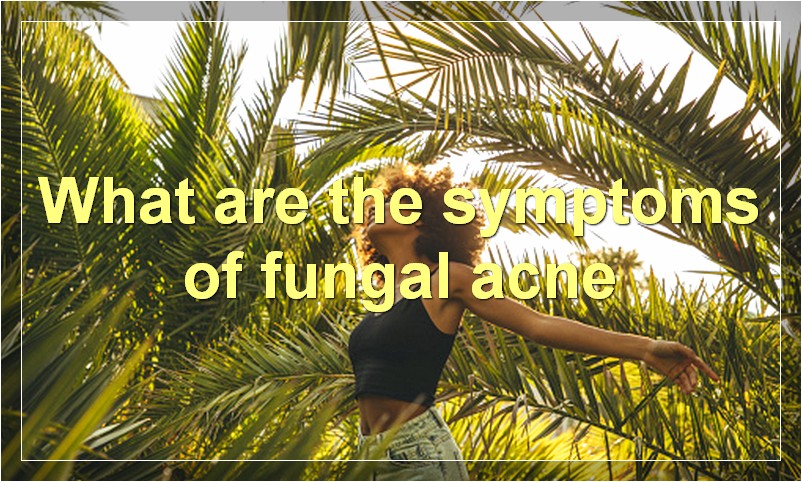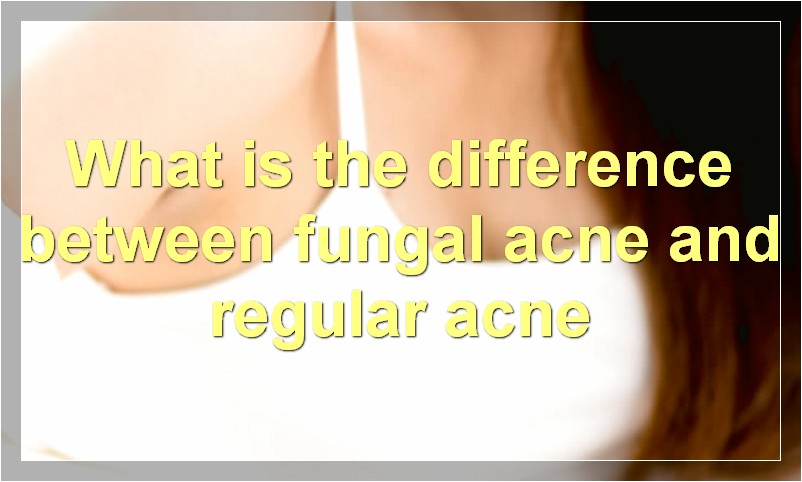If you’re struggling with acne, you might be surprised to learn that the culprit could be a type of fungus. Fungal acne is a relatively new concept, but it’s one that dermatologists are starting to pay more attention to. Here’s everything you need to know about this skin condition.
What is fungal acne
Fungal acne is a type of skin condition that is caused by an overgrowth of yeast on the skin. This can lead to red, itchy, and scaly skin. While there is no cure for this condition, there are treatments that can help to control the symptoms.
What are the symptoms of fungal acne

Fungal acne is a type of skin infection that is caused by a fungus. The most common symptoms of fungal acne are redness, itching, and scaling of the skin. The affected area may also have bumps or pimples. Fungal acne is most often found on the face, chest, and back. It is important to see a dermatologist if you think you have fungal acne so that it can be properly treated.
What causes fungal acne
Fungal acne is a type of skin infection that is caused by a fungus. The most common type of fungus that causes fungal acne is called Malassezia. This type of fungus is found on the skin of humans and animals. It is a normal part of the skin flora, but it can overgrow and cause an infection.
Fungal acne usually appears as small, red bumps on the skin. The bumps may be itchy or sore. They are often found on the face, chest, back, or shoulders. Fungal acne is not contagious and cannot be passed from person to person.
There are several factors that can contribute to the development of fungal acne. These include:
• humid or moist conditions
• warm weather
• tight-fitting clothing
• occlusive cosmetics or skincare products
• immunosuppression
Treatment for fungal acne typically involves the use of antifungal medications. These can be applied topically to the affected area or taken orally. In some cases, a combination of both treatments may be necessary.
How is fungal acne treated
Fungal acne is a type of skin condition that is caused by an overgrowth of yeast on the skin. The most common symptom of fungal acne is pimples or pustules that appear on the face, chest, back, or other areas of the body. Fungal acne is often mistaken for acne vulgaris, which is a different condition that is caused by bacteria.
There are several treatment options for fungal acne. The most common treatments are antifungal creams or lotions that are applied to the skin. These products can be purchased over-the-counter or from a prescription. Antifungal medications may also be taken orally to treat fungal acne from the inside out.
If you suspect that you have fungal acne, it is important to see a dermatologist or other skin care professional for an accurate diagnosis. This is because some skin conditions can resemble fungal acne but may require different treatment. Once a diagnosis of fungal acne has been made, there are several steps that can be taken to treat the condition and prevent it from coming back.
Can fungal acne be prevented
At its most basic, fungal acne is caused by an overgrowth of a type of yeast that’s normally found on your skin. When this yeast grows out of control, it can lead to inflammation and the formation of pimple-like bumps.
Fungal acne is often mistaken for traditional acne, but there are some key differences. For one, fungal acne bumps tend to be uniform in size and shape, while traditional acne pimples can vary widely. Fungal acne also tends to appear on the face, back, and chest, while traditional acne is more likely to show up on the face, neck, shoulders, and upper back.
There are a few things you can do to help prevent fungal acne. First, practice good hygiene by washing your face (and other affected areas) with a gentle cleanser twice a day. Be sure to remove all makeup before cleansing.
Also, avoid sharing towels, pillowcases, or other personal items with someone who has fungal acne. Finally, don’t use oily or heavy skin care products that can clog pores and trap yeast on the skin.
If you think you might have fungal acne, see a board-certified dermatologist for an accurate diagnosis and treatment plan.
What is the difference between fungal acne and regular acne

When it comes to acne, there are many different types and causes. Fungal acne is one type of acne that is caused by a fungus. Regular acne is another type of acne that can be caused by various things, such as bacteria, hormones, and genetics. So, what is the difference between fungal acne and regular acne?
Fungal acne is caused by a fungus called Malassezia. This fungus is found on the skin of humans and animals. It normally doesn’t cause any problems. However, if the fungus grows too much, it can cause an infection. This can lead to redness, itchiness, and scaling of the skin. Fungal acne is often mistaken for regular acne because the symptoms are similar.
Regular acne is a type of inflammatory acne that is caused by several things, such as bacteria, hormones, and genetics. Acne occurs when the hair follicles become clogged with oil and dead skin cells. When this happens, bacteria can grow and cause inflammation. Inflammation can lead to redness, swelling, and pain. Regular acne is more common than fungal acne and can be more difficult to treat.
So, what is the difference between fungal acne and regular acne? Fungal acne is caused by a fungus while regular acne can be caused by several things. Fungal acne is often mistaken for regular acne because the symptoms are similar. Regular acne is more common than fungal acne and can be more difficult to treat.
Is fungal acne contagious
Fungal acne is not contagious.
If you’ve ever had a bout of acne, you know how frustrating it can be. You may have even tried everything under the sun to get rid of it, but nothing seems to work. And then, just when you thought you were in the clear, you get a new breakout. But this time, it’s different. This time, it’s fungal acne.
So, what is fungal acne? Contrary to popular belief, it’s not actually acne. Fungal acne is an overgrowth of yeast on the skin that can cause redness, itching, and inflammation. It’s often mistaken for acne because it can look similar, but there are some key differences. For one, fungal acne is not contagious like regular acne is. And secondly, regular acne is caused by bacteria, while fungal acne is caused by yeast.
While fungal acne isn’t contagious, it can be difficult to get rid of. The good news is that there are some things you can do to treat it. Here are a few tips:
1. Use an anti-fungal cleanser: This will help to kill the yeast that is causing the overgrowth.
2. Avoid triggers: There are certain things that can trigger a flare-up of fungal acne. These include sweating, tight clothing, and humid conditions. If you can avoid these triggers, you may be able to prevent a breakout.
3. Treat underlying conditions: If you have any underlying conditions that may be contributing to your fungal acne (such as diabetes or a weakened immune system), treating these conditions can help to clear up your skin.
4. See a doctor: If you’ve tried all of the above and you’re still struggling with fungal acne, it may be time to see a doctor. They can prescribe medication that will help to clear up the overgrowth of yeast on your skin.
How long does fungal acne last
Fungal acne is a type of skin infection that is caused by a fungus. The most common type of fungus that causes this condition is called Malassezia. This fungus is found on the skin of humans and other animals. It does not cause any harm to the skin, but it can cause an overgrowth of yeast on the skin, which can lead to an infection.
Fungal acne usually appears as small, red bumps on the skin. These bumps are often itchy and can be accompanied by flaking or scaling of the skin. The bumps can occur on any part of the body, but they are most commonly found on the face, chest, back, or shoulders. Fungal acne is not contagious and cannot be passed from one person to another.
Fungal acne is treated with antifungal medications. These medications can be applied to the skin or taken orally. In most cases, treatment will clear up the infection within a few weeks. However, some people may need to continue treatment for several months to prevent the infection from coming back.
What are the complications of fungal acne
Fungal acne is a condition caused by an overgrowth of yeast on the skin. The most common symptoms are small, red, pimple-like bumps on the face, chest, back, or other areas of the body. Fungal acne is often mistaken for acne vulgaris, which is a different condition that is also characterized by the presence of pimples.
While fungal acne is not harmful, it can be uncomfortable and embarrassing. In some cases, it can also lead to secondary infections if the bumps are scratched or broken open. Treatment for fungal acne typically involves the use of antifungal creams or lotions. These products are available over the counter or by prescription.
If you think you have fungal acne, see your doctor or dermatologist for an accurate diagnosis.
Are there any home remedies for fungal acne
Fungal acne can be a pesky problem, but luckily there are a few home remedies that can help. Vinegar, for instance, has both antifungal and antibacterial properties, making it an ideal treatment for fungal acne. Simply dilute some vinegar with water and apply it to the affected area with a cotton ball. Let it sit for a few minutes before rinsing off.
Tea tree oil is another effective home remedy for fungal acne. It has natural antifungal and antibacterial properties that can help kill the fungus that’s causing your acne. Just add a few drops of tea tree oil to a cotton ball and apply it to the affected area. Let it dry for a few minutes before rinsing off.
If you’re looking for a more natural option, you can try using raw honey. Honey has both antifungal and anti-inflammatory properties, making it an excellent choice for treating fungal acne. Simply apply some honey to the affected area and let it sit for about 15 minutes before rinsing off.
If you’re struggling with fungal acne, give one of these home remedies a try. With regular use, you should start to see an improvement in your skin.





